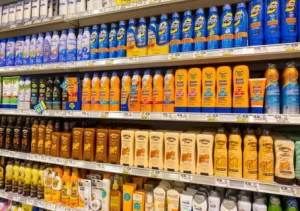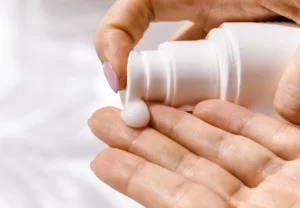Sun Protection is Still Important in the Winter
We see it every summer: Visitors to Panama City Beach sporting painful sunburns.
Many of them are using sun protection, but the SPF factor that works at home is just not high enough to protect delicate skin tissue from the sun’s rays, intensified by the reflection from the water and white sand.
They may not realize that the water and wind can wear away their protection.
And some visitors believe the sun can’t harm them on a cloudy day. (Hint: Skin-damaging UVA rays can penetrate the clouds.)
But with skin cancer and premature aging due to sun damage on our minds in the summer, it’s easy to forget about the importance of sun protection in the winter months, when the sun’s warmth isn’t a constant reminder that we need to protect our precious skin.
Sunscreen sales

During the busy season (usually April through October), you’ll see rows of sunscreen, suntan lotion and sunburn remedies almost everywhere you shop in Panama City Beach.
Grocery stores, drug stores, beachwear shops, discount stores, specialty shops – even hardware stores – stock up on sun essentials at the beginning of the busy tourist season. And they often mark the price up at the beginning of the season, too!
But when the bulk of the tourists go home, the stores are busy stocking holiday items, and sun protection gets discounted and moved to a less prominent location in the store.
So it becomes an “out-of-sight, out-of-mind” situation, and we don’t think about replenishing our supply of sun protection until the weather turns warm.
ALERT: That is a mistake we need to stop making … ASAP!
Sun Damage Still Happens in the Winter

According to Web MD, there are more than 60,000 deaths a year directly attributed to skin cancer caused by sun damage.
Unfortunately, most skin damage cannot actually be repaired.
And the damaging rays of the sun are still attacking our skin during the cooler months.
Wearing more clothing during the winter doesn’t protect us from some of those rays. UVA rays can even penetrate some clothing.
The rays that make us tan (Ultraviolet A or “longwave rays”) make up about 95% of the rays that reach the Earth.
And yes, they give us that golden, beachy glow, but they also give us dark spots, wrinkles and can initiate skin cancers.
Ultraviolet B (“shortwave rays”) cause redness and sunburns. They are most intense from the early part of spring through early fall.
How to protect yourself and your family from sun damage

We do need sun. The Vitamin D supplied by sun exposure is a vital nutrient.
And the draw of a day on a sunny beach or a refreshing dip in the pool is just too much to resist.
But we can minimize sun damage by taking a few preventive measures:
- UV rays are most intense between the hours 10:00 a.m. and 2:00 p.m., so limit exposure during the midday hour.
- Use a sunscreen with a minimum protection of SPF 25 – but use a higher SPF if your skin is fair or burns easily.
- Re-apply sun protection often. More is better.
- Cover up with protective clothing and hats. (Men with thinning or no hair, don’t forget to protect your scalp.)
- Stay away from tanning salons and sunlamps. If you want a “starter tan”, try a spray tan or a self-tanner.
- Be sure to protect children from the harsh rays of the sun.
To be sure your time on our beautiful beaches is memorable for the right reasons, be sure to include the sun protection product that’s best for you when you pack your beach bag …
And enjoy your fun in the sun!
